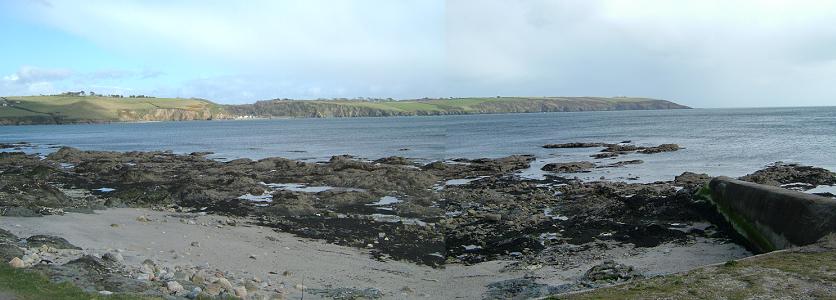| MARINE
LIFE NEWS
Reports
of marine wildlife from all around the British Isles, with pollution incidents
and conservation initiatives as they affect the flora and fauna of the
NE Atlantic Ocean
19
August 2009
Green
seaweed has been clogging parts of the
English coastline, and from the air above Langstone Harbour in Hampshire
it resembles a massive algal green carpet. This amount of seaweed has a
detrimental effect on the underlying fauna deoxygenating the mud and killing
the worms and cockles etc.
BBC
News Report
The
continual problem also occurred off the shores of Brittany.
BBC
News Report
12
- 14 August 2009
Thousands
of fish have died of suffocation in the seas of St.
Austell Bay in south Cornwall.
"The
more we looked, the more dead fish we found, mainly small ones, but eventually
even about half a dozen Cuckoo Wrasse,
Labrus
bimaculatus, - a beautiful red and
blue fish, and some others which someone identified as baby Dogfish,
Scyliorhinus
canicula,
all unmarked but dead in
rock pools or on the shoreline. One chap even hauled out a large Conger
Eel, Conger conger, from a pool,
obviously dead."
The
dead fish coincided with a large bloom
of plankton that had been blown into the bay. The bloom had turned
the water brown and left sludge deposit on the shore. The exact species
has not yet been identified.
Western
Morning News Report
Wild
About Britain Forum (Report)
BBC
News Report (1)
BBC
News Report (2)
"The
Status of Rockpools at Spit Point, Par, Cornwall.
I
had a very sad afternoon, although the afternoon began very promising despite
what had been forecast on the news. On venturing onto the beach at Spit
Point there were no obvious signs of washed up fish or anything and the
first upper shore rockpools I checked were teaming with small fry and other
life, however this didn't last long and it wasn't long before I started
to find dead gobies.
On
looking in upper-middleshore pools things got a lot worse and Green
Sea-Urchins, Psammechinus
miliaris, were laying on the bottom
of pools somewhat lifeless (usually they are all under rocks), along with
various species of marine worms.

Dead
Sandeels
and Two-spotted Gobies
were common place and I also came across a dead 3 lb Ballan Wrasse
in the large upper shore pools. Towards Par Dock Breakwater the upper shore
was stinking of hydrogen sulphide
and especially where small mussel
colonies ventured into some of the smaller pools. Here there was also a
film and foam on the pools. On venturing back I took images of near lifeless
Snakelocks
Anemones, dead crabs and images of the
colour of the water at low water mark, which was quite dark and murky.
The
status of Par Beach, Cornwall.
I
decided to visit Par Beach after Spit Point and to see what was happening
there. The first thing I saw was thousands of Sea
Potatoes washed together just below the
high water mark. Dead Sea Potatoes
were common place all down the beach. I then noticed that there was an
increase in the amount of Common Cockles
on the surface of the sand. Then came a real shock, thousands of half-dead
and dead lugworm
all across the beach, many had been speared by beaks of seabirds, thousands
must have already been eaten.
A
yellowish-brown scum could be found all over the beach in lines below the
high tide mark down to low water."
Web
Site Report by David
Fenwick
10
August 2009
A
15 cm juvenile Loggerhead Turtle,
Caretta
caretta, was rescued after stranding on on Loe
Bar, near Porthleven,
in Cornwall. It was discovered by by Rose
Ledbury from Warwick. The turtle was surrounded
by a number of stranded Portuguese Man-o'War, Physalia
physalis, one of the Loggerhead's
staple foods. The turtle is recovering in a special quarantine unit at
the Blue Reef Aquarium in Newquay.
BMLSS
Turtles
BMLSS
Portuguese Man-o'War
2 August
2009
A
Bogue,
Boops boops,
was caught in a Red Mullet
net in 10 metres of water about half a mile off the shore at Seaton, south
east Cornwall, by Chris Dominic on the FV
Emma May.
This
fish was about 17 cm (6 - 7"), but they can grow to 38 cm (14").
They are a shoaling fish and are a commercial species in southern Europe.
They are classified in the Sparidae Sea Bream
family and I assume they are good eating. They are rare in British
waters and most have been caught in the Channel Islands, but they have
also been found in Torbay and several other places. They are regularly
caught in Red Mullet nets in Mount's Bay Cornwall in the autumn, but this
is the first I had heard of from Whitsand Bay.
BMLSS
Sea Breams
-------------------------------------------------------------------------------------------------------------------------
FORUM
NEWS
Marine Wildlife
of the North-east Atlantic Ocean Mailing Groups
Marine
Wildlife of the North-east Atlantic Ocean
Yahoo
Group
New
Group: http://uk.groups.yahoo.com/group/Glaucus
With
the closure of Smart Groups at the end of November
2006
most of the 7500+ messages have been
filed at:
Marine
Wildlife of the North-east Atlantic Ocean Jiglu
http://www.Jiglu.com/spaces/glaucus/
Images
can be uploaded to flickr.
http://www.flickr.com/groups/glaucus/
Wet
Thumb (Marine Aquariology) Forum Link

------------------------------------------------------------------------------------------------------
All
reports by Andy Horton unless the credits are given
to
other observers or reporters.
Cornish
Marine Wildlife (Ray Dennis Records) 2008
|

